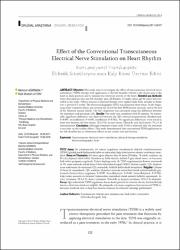| dc.contributor.author | Ağırman, Mehmet | |
| dc.contributor.author | Aydın, Halil İbrahim | |
| dc.date.accessioned | 2021-01-20T09:44:44Z | |
| dc.date.available | 2021-01-20T09:44:44Z | |
| dc.date.issued | 2018 | en_US |
| dc.identifier.citation | Ağırman, M. ve Aydın, H. İ. (2018). Effect of the conventional transcutaneous electrical nerve stimulation on heart rhythm. Journal of Physical Medicine and Rehabilitation Sciences, 21(3), 122-125. https://doi.org/10.31609/jpmrs.2017-58107 | en_US |
| dc.identifier.issn | 1309-3843 | |
| dc.identifier.issn | 1307-7384 | |
| dc.identifier.uri | https://doi.org/10.31609/jpmrs.2017-58107 | |
| dc.identifier.uri | https://hdl.handle.net/20.500.12511/6313 | |
| dc.description.abstract | Objective: This study aims to investigate the effect of transcutaneous electrical nerve stimulation (TENS) therapy with application to the left shoulder (which is the closest area to the heart in daily practice) and to measure the electrical activity of the heart. Material and Methods: Forty-four patients who had left shoulder pain (29 females, 15 males; mean age 53 years) were enrolled in the study. Fifteen sessions of physical therapy were applied daily from monday to friday over a period of 3 weeks. The electrocardiography (ECG) was measured three times: At the beginning of the treatment (first), just towards the end of the first TENS session (second), and at the end of the fifteenth session (third). The QTc dispersion was calculated using the difference between the maximum and minimum QTc. Results: The study was completed with 41 patients. No statistically significant difference was observed between the QTc interval measurements (first&second: P=0.597, second&third: P=0.601, first&third: P=0.762). No significant differences were noted in heart rate between the first (mean: 78.3±7.9), second (mean: 78.6±6.8), and third (mean: 79.2±7.4) measurements. Conclusion: Although treatment of pain with TENS is relatively safe, the literature is not clear on the cardiac effects. This study demonstrated that conventional TENS application to the left shoulder has no deleterious effects on the cardiac rate and rhythm. | en_US |
| dc.description.abstract | Amaç: Bu çalışmamızda, sol omuza uygulanan transkutanöz elektrik stimülasyonunun (TENS) (günlük pratik kullanımda kalbe en yakın alan) kalp ritmi üzerine etkisini incelemeyi amaçladık. Gereç ve Yöntemler: Sol omuz ağrısı şikayeti olan 44 hasta (29 kadın, 15 erkek; ortalama yaş 53 yıl) çalışmaya dahil edildi. Hastalara üç hafta süreyle, haftada 5 gün olmak üzere, on beş seans fizik tedavi programı uygulandı. Tedavi başlangıcında, ilk TENS uygulamasının hemen sonrasında ve 15. seans sonunda olmak üzere 3 kez elektrokardiyografi (EKG) ölçümü yapıldı. QTc dispersiyonu maksimum ile minimum QTc arasındaki farklılık kullanılarak hesaplandı. Bulgular: Çalışma 41 hasta ile tamamlandı. QTc aralıkları ölçümleri arasında istatistiksel olarak anlamlı farklılık gözlenmedi (birinci/ikinci uygulama: P=0.597, ikinci&üçüncü: P=0.601, birinci&üçüncü: P=0.762). Kalp hızları arasında da ölçümler bakımından istatistiksel olarak anlamlı farklılık saptanmadı: birinci (ortalama: 78.3±7.9), ikinci (ortalama: 78.6±6.8) ve üçüncü (ortalama: 79.2±7.4) ölçümler. Sonuç: Ağrı tedavisinde TENS uygulaması her ne kadar güvenli bir yöntem olsa da, literatürde kalp üzerine etkisi tam olarak net değildir. Bu çalışmada, sol omuza uygulanan konvansiyonel TENS tedavisinin kardiyak ritm ve kalp hızı üzerine olumsuz bir etkisinin olmadığı görülmüştür. | en_US |
| dc.language.iso | eng | en_US |
| dc.publisher | Türkiye Fiziksel Tıp ve Rehabilitasyon Uzman Hekimleri Derneği | en_US |
| dc.rights | info:eu-repo/semantics/openAccess | en_US |
| dc.subject | Transcutaneous Electrical Nerve Stimulation | en_US |
| dc.subject | Physical Therapy Modalities | en_US |
| dc.subject | Electrocardiography | en_US |
| dc.subject | Heart | en_US |
| dc.subject | Transkutanöz Elektrik Sinir Stimülasyonu | en_US |
| dc.subject | Fizik Tedavi Yöntemleri | en_US |
| dc.subject | Elektrokardiyografi | en_US |
| dc.subject | Kalp | en_US |
| dc.title | Effect of the conventional transcutaneous electrical nerve stimulation on heart rhythm | en_US |
| dc.title.alternative | Konvansiyonel transkutanöz elektrik stimülasyonunun kalp ritmi üzerine etkisi | en_US |
| dc.type | article | en_US |
| dc.relation.ispartof | Journal of Physical Medicine and Rehabilitation Sciences | en_US |
| dc.department | İstanbul Medipol Üniversitesi, Tıp Fakültesi, Dahili Tıp Bilimleri Bölümü, Fizik Tedavi ve Rehabilitasyon Ana Bilim Dalı | en_US |
| dc.authorid | 0000-0003-1757-1814 | en_US |
| dc.identifier.volume | 21 | en_US |
| dc.identifier.issue | 3 | en_US |
| dc.identifier.startpage | 122 | en_US |
| dc.identifier.endpage | 125 | en_US |
| dc.relation.publicationcategory | Makale - Ulusal Hakemli Dergi - Kurum Öğretim Elemanı | en_US |
| dc.identifier.doi | 10.31609/jpmrs.2017-58107 | en_US |


















